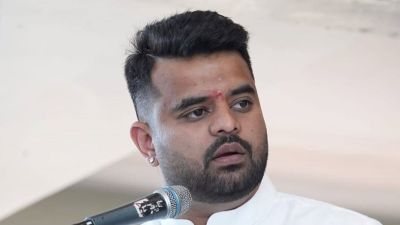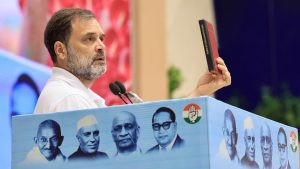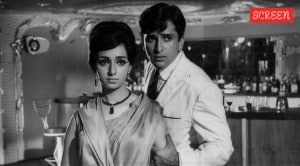Click here to follow Screen Digital on YouTube and stay updated with the latest from the world of cinema.
Drishyam 2: Ajay Devgn’s thriller is selling a middle-class male fantasy, without pausing to self-reflect
Post Credits Scene: Although it's arguably a better movie than most Bollywood hits of 2022, Ajay Devgn's Drishyam 2 presents a version of masculinity that had almost gone out of fashion until the pandemic thrust Indian filmmaking back into the prehistoric age.
 Ajay Devgn in a still from Drishyam 2.
Ajay Devgn in a still from Drishyam 2. Of all the Hindi movies that did well financially in 2022 — Brahmastra, Gangubai Kathiawadi, Bhool Bhulaiyaa 2, and even The Kashmir Files — the most head-scratching inclusion ironically also happens to be the better than the rest. It made no sense when Drishyam 2, the almost mechanically efficient sequel to the 2015 original — which itself was a remake of the hit Malayalam film starring Mohanlal — emerged as the year’s second-biggest Hindi movie, especially in a year that produced bombastic entertainment such as RRR, Kantara and KGF: Chapter 2.
How could a relatively grounded thriller end up making more money than a lavish period epic directed by an A-lister, a foul piece of propaganda that pandered to the majoritarian mindset, and a comedy sequel starring a genuine up-and-comer? And no, the answer isn’t Tabu. In an interview, filmmaker Karan Johar presented the rather plausible theory that Drishyam 2 did well purely because a Hindi dub doesn’t exist for the Malayalam original. Indian audiences, as it turns out, aren’t quite willing to overcome the barrier of subtitles just yet. But watching the movie on Prime Video, you’re struck by one rather elemental reason why this franchise could have captured the imagination of the masses, and why, after having spawned seven remakes, it remains probably the most resilient IP in Indian cinema history.
Drishyam 2 (and indeed, the first film as well), presents a version of masculinity that had almost gone out of fashion until the pandemic thrust Indian filmmaking back into the prehistoric age. “Mere liye meri family meri duniya hai,” Ajay Devgn, a sentient monolith of machismo if there ever was one, says as Vijay Salgaonkar in a voiceover at the end of the film. “Unke liye main kuch bhi kar sakta hoon. Kissi bhi hadd tak jaa sakta hoon.”
Unlike Rocky bhai or Shiva, Vijay doesn’t solve his problems with (physical) violence. But he means business when he says that he can go to any lengths. A borderline psychopath in the first film, Vijay clearly has no clue how harmful his devotion to family actually is. Of course, the movie never pauses to unpack the actions of its protagonist, mostly because it in such awe of him. It’s almost as if both Vijay and the movie have deluded themselves into believing that he is some kind of dutiful male protector, when, in fact, he has little respect for any of the three women in his life. Somewhere along the way, the lines begin to blur between his efforts to protect them and his determination to outsmart the police.
In Drishyam 2, he allows the police to physically assault his daughter, purely because it’s a part of his plan. He’s clever, we’re told, over and over again; that’s pretty much his entire thing. Couldn’t he have come up with a scheme that didn’t involve the third degree torture of his teenage children? Instead, every eventuality — and we haven’t spoken about the psychological trauma his actions have inflicted yet — is brushed off as collateral damage in one man’s noble mission to uphold the honour of his family.
The inciting incident of the first movie — the sexual harassment of Vijay’s elder daughter Anju — is barely even mentioned in Drishyam 2, as director Abhishek Pathak trains his focus on Vijay, the only man involved, and his reaction to the incident. We’re told that poor Anju has started having seizures, probably because of past events, but the movie doesn’t really flesh her out in any way, choosing instead to use her trauma for plot purposes.
But like its nonchalant protagonist, Drishyam 2 is disinterested in the moral ramifications of Vijay’s actions. It isn’t as egregious as the first season of Prime Video’s Breathe, which takes a similar premise a step further, and has its hero orchestrate serial killings in an effort to save his terminally ill son. But it’s hardly as complex as SonyLIV’s Tabbar either. And that’s because it leaves Vijay unchecked; he’s unbothered by the gossip surrounding him, and utterly unconcerned about his wife Nandini’s visible anxiety.
Having spent the previous seven years in complete confusion — like most Indian men, Vijay doesn’t communicate with his wife — Nandini has been reduced to a nervous wreck. She flinches at the drop of a feather, and feels unmoored from reality has her husband goes about his life as if nothing has happened. Had Vijay simply allowed her to participate in his schemes, or at least informed her about what he was doing, it would’ve put her mind at ease. But no; he looks down on her, he disrespects her intelligence, and gaslights her into thinking that they’re safe. Vijay refuses to keep her in the loop not because she can’t help, but because he’s afraid she might indict herself by blabbing.
Which she eventually does, of course, to the first adult human who’s willing to listen to what she has to say. But this comes across as the movie’s way of saying that Vijay’s fears weren’t unfounded; women can’t be trusted with precious cargo. This is nonsense, of course. Everybody knows that it’s usually the women who handle the financials of middle class homes.
Speaking of financials, in the seven years since the first film, we’re told that Vijay has turned into something of a business magnate. He’s no longer a small-timer who operates a cable TV business; Vijay now owns a movie theatre, and lives in a sprawling new house with his obedient brood. Vijay is a social climber; a mascot for every Indian male with aspirations of a better life. He’s a ‘chauthi-fail’ who challenged authority and privilege, outwitted both, and was rewarded handsomely. Vijay’s living the dream — he has a non-threatening wife who doesn’t meddle in his affairs and rolls over when he wants sex, he’s convinced that he’s smarter than everybody else, and most importantly… he drives an SUV. No wonder this movie appealed to the masses. This could be you, it seems to be saying with a sly smile on its face. And people bought it, twice over, in Hindi, Tamil, Telugu, Kannada and Malayalam.
Post Credits Scene is a column in which we dissect new releases every week, with particular focus on context, craft, and characters. Because there’s always something to fixate about once the dust has settled.


Photos


- 01
- 02
- 03
- 04
- 05






























